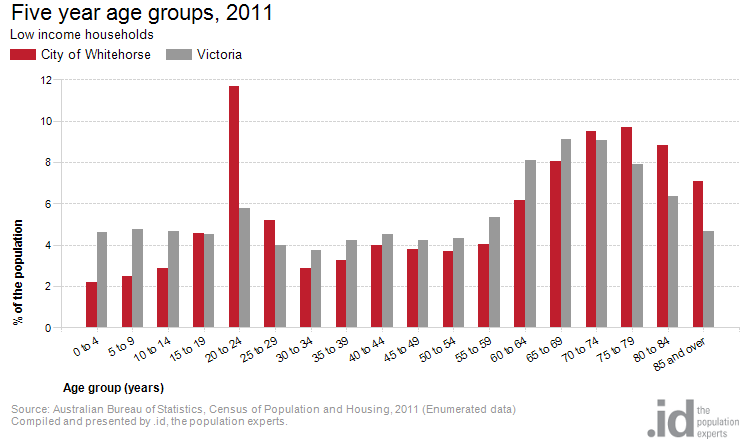Box Hill is a rapidly growing satellite CBD in Greater Melbourne, and home to one of the city’s largest Chinese-born populations. The local council is interested in understanding more about this growing population to help them provide the most appropriate services. Do they require language services? Are they able to find appropriate housing and employment? Here we demonstrate how to tell this story that you might find helpful if you work in a council or community services organisation.
The City of Whitehorse is one of the more affluent areas of Melbourne, and also one of the more culturally diverse, with big increases in Chinese and Indian populations in the last ten years.
There were 11,000 people living in Whitehorse who were born in China, and over 20,000 who speak Chinese languages at home. Fourteen percent of these were born locally in Australia, with many also from Malaysia, Hong Kong and Vietnam. Most importantly, the data shows that 24% of these Chinese speakers have self-assessed poor English proficiency, slightly higher than the Melbourne average for Chinese speakers, indicating that Chinese language publication and translation services may be particularly useful in Whitehorse.
We can see that the Chinese population of Whitehorse is very young compared to the Chinese across Greater Melbourne. Forty-five percent of the population are aged between 18 and 30. Until recently, Whitehorse’s population had been on an aging trajectory, but the new migrant groups have reversed this trend, with the largest increases now in younger age groups.

The reason this population is so young is that Whitehorse has become an epicentre for overseas students attending university – both the Deakin Burwood Campus which is in the area, and those attending inner city universities, using the frequent express trains. Twenty-four percent of all Chinese-born residents living in the City of Whitehorse are attending university.
Consequently, many are living in group households (18%) or as couples without children (26.0%), although a sizeable 37.3% had kids at home as well (compared to 51.6% for Whitehorse’s total population).
The Chinese-born population in Whitehorse are most likely to be renting (42%), but 37% have a mortgage and this also showed a big increase between 2006 and 2011. They are also quite likely (35%) to be in medium and high density housing, but nevertheless, the largest increase was Chinese living in separate houses, which make up the bulk of Whitehorse’s housing stock.
For the Chinese population who are in the labour force, the unemployment rate is high, at 12.2%, more than double the average for Whitehorse overall. However it did improve between 2006 and 2011.
Contrast this to another large cultural group, the Indian-born population. Here, the unemployment rate is only 5.0% – less than the average, and there is a relatively low level of university attendance. The Indian-born population are also young, but mainly in the 25-34 age range, already qualified and working. Fifty-nine percent have a degree qualification, compared to 39% for Chinese (both these rates are higher than the general population).
The Chinese living in Whitehorse have quite low incomes because of the large numbers of students and high unemployment. In fact, there are two very distinct low income groups in Whitehorse – students at one end and elderly pensioners at the other. Whitehorse is a well off area and has very little working age low income population.

To summarise, in Whitehorse we have a student and young adult Chinese population, attending university locally or in inner Melbourne, and increasingly settling down and having families, buying into the area to stay long-term. There is an issue with a high unemployment rate, however, and this is likely to be exacerbated by relatively low rates of English proficiency.
These insights can help local government to understand the services required for culturally diverse communities and other communities of interest.
About this project
The City of Whitehorse has become the latest Australian council to subscribe to .id’s Communities of Interest online resource. The Communities of Interest allow you to delve deeper into the characteristics of sub-groups within the population by using carefully presented Census cross-tabulations that help you craft the story of each community.
Learn more about Communities of Interest online resources or see our video about how you can use Communities of Interest for your area.













